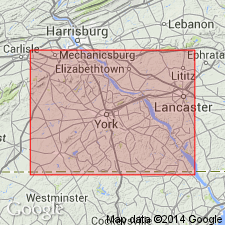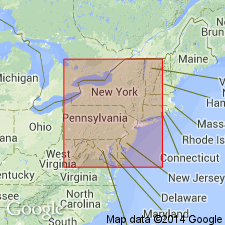
- Usage in publication:
-
- Conewago conglomerate member*
- Modifications:
-
- Named
- Dominant lithology:
-
- Conglomerate
- Sandstone
- AAPG geologic province:
-
- Piedmont-Blue Ridge province
- Gettysburg basin
Summary:
A thick lenticular zone of hard red pebbly arkosic sandstone and conglomerate near the base of the Gettysburg Shale is named the Conewago Conglomerate Member. It extends from southwest of Airy Hill School in western York Co., PA, northeastward through Harmony Grove and Conewago Mountain to northwest of Strinestown. Maximum thickness is 7,300 ft. Age is Late Triassic.
Source: GNU records (USGS DDS-6; Reston GNULEX).

- Usage in publication:
-
- Conewago Conglomerate Member
- Modifications:
-
- Not used
- AAPG geologic province:
-
- Piedmont-Blue Ridge province
- Gettysburg basin
Summary:
That part of the Gettysburg Formation designated Conewago Conglomerate Member by Stose and Jonas (1939) was examined at seven exposures and was not separable from typical Gettysburg lithologies. The name Conewago is not recognized and rocks in the area designated Conewago are part of the undifferentiated lower unnamed member of the Gettysburg Formation.
Source: GNU records (USGS DDS-6; Reston GNULEX).
For more information, please contact Nancy Stamm, Geologic Names Committee Secretary.
Asterisk (*) indicates published by U.S. Geological Survey authors.
"No current usage" (†) implies that a name has been abandoned or has fallen into disuse. Former usage and, if known, replacement name given in parentheses ( ).
Slash (/) indicates name conflicts with nomenclatural guidelines (CSN, 1933; ACSN, 1961, 1970; NACSN, 1983, 2005, 2021). May be explained within brackets ([ ]).

